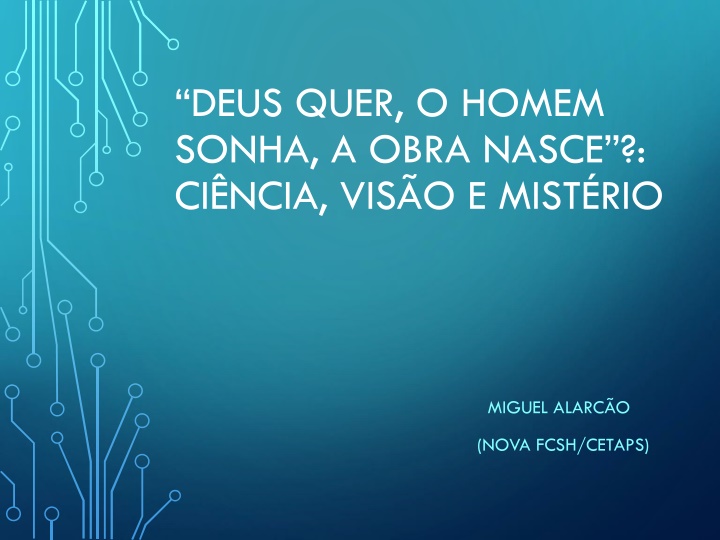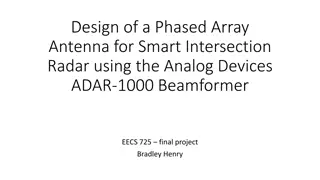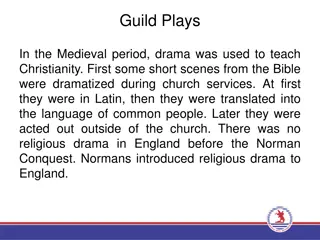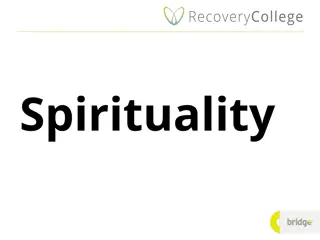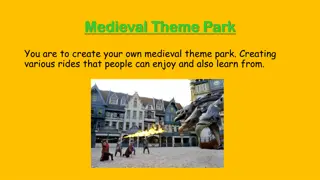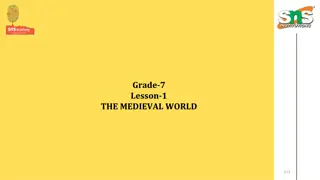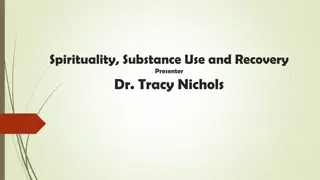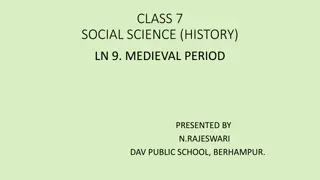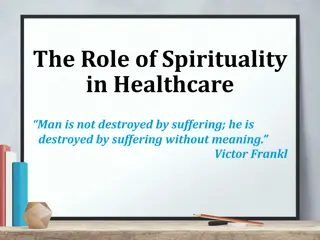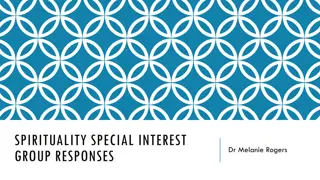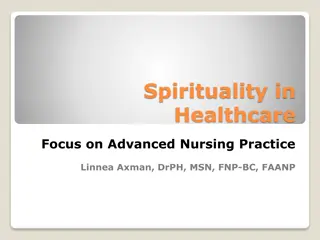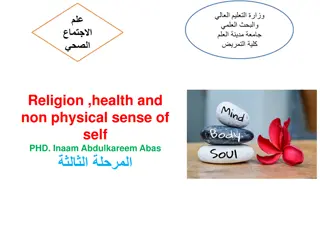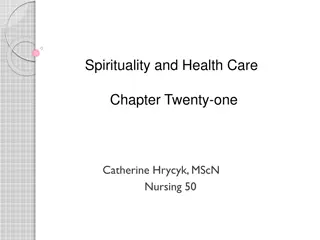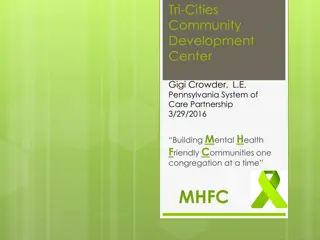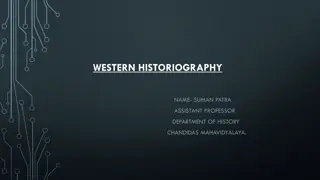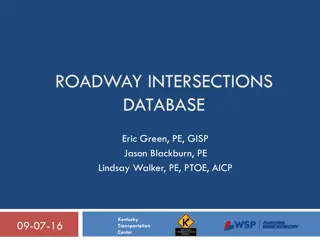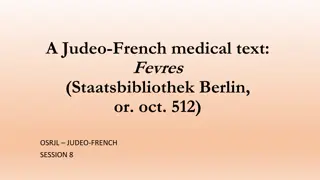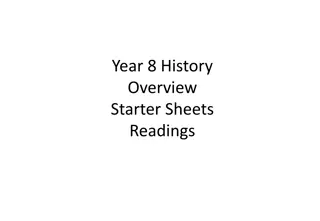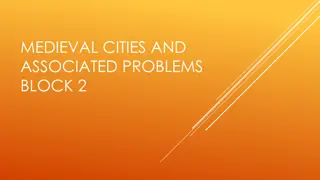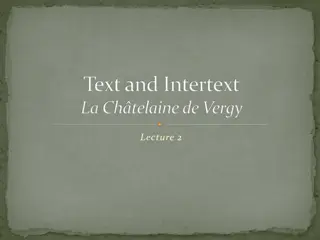The Intersection of Science and Spirituality in Medieval Times
The exploration of scientific curiosity during the Middle Ages reveals a deep connection between geometry, arithmetic, and astronomy with the understanding of natural phenomena. Scholars like Roger Bacon embraced the importance of mathematics, optics, and astronomy in comprehending the universe, highlighting a balance between faith and reason. Despite challenges, scientific pursuits in Medieval times laid the foundation for future advancements.
Download Presentation

Please find below an Image/Link to download the presentation.
The content on the website is provided AS IS for your information and personal use only. It may not be sold, licensed, or shared on other websites without obtaining consent from the author.If you encounter any issues during the download, it is possible that the publisher has removed the file from their server.
You are allowed to download the files provided on this website for personal or commercial use, subject to the condition that they are used lawfully. All files are the property of their respective owners.
The content on the website is provided AS IS for your information and personal use only. It may not be sold, licensed, or shared on other websites without obtaining consent from the author.
E N D
Presentation Transcript
DEUS QUER, O HOMEM SONHA, A OBRA NASCE ?: CI NCIA, VIS O E MIST RIO MIGUEL ALARC O (NOVA FCSH/CETAPS)
By losing our dependence on authority we may have ushered in a world of scientific wonders, but we have also replaced the comfort of certainty with the discomfort of doubt. Even so, the balance seems to be in favour of the scientific revolution. ( ) And though in the short term there was a loss of a spiritual anchor when scientific rationalism attempted to take over from religion, in the longer term religion has proved robust enough to survive the scientific revolution. (Clegg, 2003: 205-206)
() a Idade Mdia no teve curiosidade cientfica? Um simples cat logo dos manuscritos contidos nas nossas ( ) bibliotecas bastaria para responder quest o: o invent rio completo dos tratados de medicina, de matem tica, de astronomia, de alquimia, de arquitectura, de geometria e outros n o foi ainda levado a cabo, e os seus textos permanecem, na maior parte, in ditos. Os esfor os tentados nesse sentido foram at aqui fragment rios e n o permitem uma vis o de conjunto da ci ncia medieval. Mas o que se sabe ( ) permite constatar que ela foi muito mais extensa do que o que tem podido supor- se ( ) Um Roger Bacon, em pleno s culo XIII, conhecia a p lvora de canh o, o uso das lentes convexas e c ncavas. (Pernoud, 1997: 157; negrito nosso)
Tanto a geometria como a aritmtica detinham um grande valor por serem essenciais compreens o dos modos de funcionar da natureza e descri o da variedade de movimentos e ac es verificada no mundo. A nfase dada, na Idade M dia, geometria e aritm tica devia fazer hesitar aqueles que t m defendido que os fil sofos naturais e os te logos medievais eram hostis matem tica. A ci ncia da astronomia, que inclu a a astrologia, era igualmente louvada ( ) como instrumento essencial para compreender o universo. ( ) Roger Bacon considerava-a essencial Igreja e ao Estado, bem como aos lavradores, alquimistas e m dicos. (Grant, 2002: 54; negrito nosso)
One of the seeming paradoxes of the thirteenth century is that the greatest development in mathematics, optics, and astronomy went with the most transcendental outlooks. ( ) At a time when St Thomas was trying to make a distinction between faith and reason, Bacon was asserting the subordination of all knowledge to theology. He did not differ from his contemporaries over aims and beliefs so much as over method. ( ) Where Bacon differed from the majority of his confr res was in the other aspect of knowledge. Whilst on the one hand there was the inner experience which came with illumination, on the other there was empirical knowledge which derived from external sources. Together they made up experience. (Leff, 1962: 246- 247 passim; negrito nosso)
I left you in Laon, so that I could give my full attention to the work done by the Arabs, while you no less zealously imbibed the changing opinions of the French. ( ) I learnt from my masters, the Arabs, to follow the light of reason, while you are led by the bridle of authority; for what other word than bridle can I use to describe authority? (Apud Southern, 1988: 86).
The silly Fryers [sic] envying his too prying head, by their craft had almost got it off his shoulders. It s dangerous to be wiser than the multitude, for that unruly Beast will have every over-topping head to be lopped shorter, lest it plot, ruine [sic], or stop the light, ( ) (Bacon, 2015: 210)
Glasses and Perspectives may be framed, to make one thing appear many, one man an Army, the Sun and Moon to be as many as we please. ( ) By the framing of Glasses, bodies of the largest bulk, may in appearance be contracted to a minute volume, things little in themselves show great, while others tall and lofty appear low and creeping, things creeping and low, high and mighty, ( ) (Cap. V, Of PerspectiveArtificial Experiences in Bacon, 2015: 231-232)
We may read the smallest letters at an incredible distance, we may see objects however small they may be, and we may cause the stars to appear wherever we wish. (Apud Clegg, 2003: 44) ( ) very large objects can be made to appear small, and the reverse, and very distant objects will seem very close at hand, and conversely. ( ) Thus from an incredible distance we might read the smallest letters and number grains of dust and sand owing to the magnitude of the angle under which we viewed them ( ) (Apud ibidem: 48)
Fabricar-se-o () instrumentos para navegar sem o auxlio de remadores, e para que os maiores navios possam vogar tendo um s homem de tripula o, e movendo-se com maior velocidade do que se levassem muitos mareantes. Haver carros que, sem cavalos, correr o com uma rapidez imposs vel de imaginar. H o-de construir-se aparelhos para voar, e no meio deles, indo o homem sentado, movendo um certo maquinismo (ingenium), despregar as suas asas fict cias, e cortar os ares, como fazem as aves com as suas asas naturais. ( ) Um outro instrumento servir para tirar qualquer objecto resistente por cima de um terreno liso, e permitir a um s homem o puxar mil pessoas contra sua vontade. Haver um mecanismo para descer ao fundo do mar e dos rios sem o m nimo acidente; aparelhos para nadar e pairar debaixo da gua. Sobre os rios se erigir o pontes sem colunas nem peg es. (Apud Coelho, 1988: 28-29)
manifestamente um esprito vidente que, inspirando-se na contempla o do g nio do homem, se levanta em voos temer rios acima da ci ncia do seu s culo, para descortinar em horizontes ainda nebulosos os prod gios do nosso tempo. Estes navios que vogariam sem mareantes seriam j na mente iluminada ( ) do franciscano de Ilchester a adivinha o destes modernos colossos navais movidos pelo vapor? Estes carros que voariam sem que fossem tirados por cavalos seriam os vag es do nosso tempo, levando por corsel [sic] a locomotiva, este animal prodigioso, que desentranha do carv o o diamante da ind stria ( )? Os aparelhos para voar serias [sic; seriam] os aerostatos, que sulcar o quem sabe? um dia os ares, naves oner rias do com rcio futuro, talhando as nuvens como os barcos actuais afrontam no Oceano as tempestades? Estas pontes sem ab badas seriam as p nseis do nosso tempo, estradas a reas lan adas graciosamente sobre as torrentes caudalosas? (Ibid.: 29-30)
That which is below is like that which is above & that which is above is like ye which is below to do ye miracles of one only thing. (Hermes Trismegistus, 2013: 14, #2; trad. de Isaac Newton, c.1680). The creative force and the material universe are locked in an eternal embrace or endless creative waltz. ( ) God is the universe, and vice-versa. Intelligent beings are part of God, and also, as their minds help shape the universe, they enjoy a special role in creation. Creator, created and creation are constantly circling in a dazzling dance of ultimate meaning and purpose, an endless jump of joy. (Picknett e Price, 2016: 329)
POTNCIA DE 10 POT NCIA DE 10 POT NCIA DE 10 DO MICRO AO MACROCOSMO PowerPointe recebido sem os creditos Reorganizado por Ricardo Lyra M sica: Once you had gold DO MICRO AO MACROCOSMO MACROCOSMO DO MICRO AO . PowerPointe recebido sem os creditos Reorganizado por Ricardo Lyra M sica: Once you had gold Reorganizado por Ricardo Lyra M sica: Once you had gold PowerPointe recebido sem os creditos . .
Referncias e sugestes bibliogrficas: Al-Asrar, Kitab Sirr. Secretum Secretorum. Translated by Robert Copeland, 1528. Edited by Tarl Warwick. S.l.: Createspace Independent Publishing Platform, 2016. Bacon, Roger, Four Works of ---. Radix Mundi. The Mirrour of Alchimy. The Oil of Antinomy. Miracles of Art, Nature and Magick. Stuarts Draft, VA: R.A.M.S. Publishing Company, col. The R.A.M.S. Library of Alchemy , vol. 32, 2015. ---. Frier [sic] Bacon His Discovery of the Miracles of Art, Nature and Magick [sic]. Faithfully translated out of Dr. Dees [sic] Own Copy, by T. M. and never Before in English. In Roger Bacon. Four Works of ---. Radix Mundi. The Mirrour of Alchimy. The Oil of Antinomy. Miracles of Art, Nature and Magick. Stuarts Draft, VA: R.A.M.S. Publishing Company, col. The R.A.M.S. Library of Alchemy , vol. 32, 2015, pp. 209-258 (London: Printed for Simon Miller at the Starre in St. Paul s Church-Yard, 1659). Brewer, Ebenezer Cobham, Brewer s Dictionary of Phrase and Fable, 9th. ed., London: Cassell & Company Ltd., 1965. Carton, Raoul, L exp rience physique chez Roger Bacon. Contribution l tude de la m thode et de la science exp rimentale au XIII si cle. Paris: Librairie Philosophique J. Vrin, col. tudes de philosophie m dievale , II, 1924 (BNP R. 10866 V.). Coelho, Latino, A Ci ncia na Idade M dia. Fixa o do Texto, Pref cio e Notas de Pinharanda Gomes. Lisboa: Guimar es Editores, col. Filosofia & Ensaios , 1988. Charles, Michael et alii, A Roger Bacon Reader. A Short Biography. The Mirror of Alchemy. The Root of the World. Sequim, WA, USA: Holmes Publishing Book LLC, 2007 (1983). Clegg, Brian, The First Scientist. A Life of Roger Bacon. New York: Carroll & Graf Publishers/Avalon Publishing Group, Inc., 2003.
Espinosa, Fernanda, Antologia de Textos Histricos Medievais. 3 ed. Lisboa: Livraria S da Costa Editora, 1981, pp. 267-268. Grant, Edward, Os Fundamentos da Ci ncia Moderna na Idade M dia. Trad. Carlos Grifo Babo. Coord. e revis o Ana Sim es e Henrique Leit o. Porto: Porto Editora, Lda., col. Hist ria e Filosofia da Ci ncia , 4, 2002. ---, The Foundations of Modern Science in the Middle Ages. Their Religious, Institutional, and Intellectual Contexts. Cambridge: Cambridge University Press, Cambridge History of Science , 2011 (1996). Harvey, Sir Paul, The Oxford Companion to English Literature. 4th ed., revised by Dorothy Eagle. Oxford: Clarendon Press, 1983 (1932). Knowles, David, TheEvolution of Medieval Thought. Ed. D. E. Luscombe e C. N. L. Brooke. 2nd ed. Harlow, Essex: Longman Group UK Ltd., 1988 (1962), pp. 257-260. Leff, Gordon, Medieval Thought. St. Augustine to Ockham. Harmondsworth: Penguin Books, 1962 (1958), pp. 246-249. Lewis, C. S., The Discarded Image. An Introduction to Medieval and Renaissance Literature. Cambridge, at the University Press, 1964. Little, A. G. (ed.), Roger Bacon Essays. Miami, Florida: HardPress Publishing, Classics Series , s.d. (Roger Bacon Essays Contributed by Various Writers on the Occasion of the Commemoration of the Seventh Centenary of His Birth. Oxford: Clarendon Press, 1914). Loyn, H. R. (ed.), The Middle Ages. A Concise Encyclopaedia. London: Thames and Hudson Ltd., 1991 (1989), p. 45 e pp. 294-295. Luscombe, David, O Pensamento Medieval. Mem Martins: Publica es Europa-Am rica, col. Forum da Hist ria , 35, 2000 (Medieval Thought. A History of Western Philosophy. Oxford: Oxford University Press, 1997), pp. 108-110.
Muir, M. M. Pattison, Roger Bacon: His Relations to Alchemy and Chemistry in A. G. Little (ed.), Roger Bacon Essays. Miami: HardPress Publishing, Classics Series , s.d., pp. 285-320. Pernoud, R gine, Luz sobre a Idade M dia. Mem Martins: Publica es Europa-Am rica, col. Forum da Hist ria , 26, 1997 (Lumi re du Moyen Age. S.l.: ditions Grasset et Fasquelle, 1981). Picknett, Lynn e Clive Prince. The Forbidden Universe. The Occult Origins of Science and the Search for the Mind of God. London: Constable, 2016 (2011). Price, B. B., Introdu o ao Pensamento Medieval. Porto: Edi es ASA, col. Textos de Apoio , 1996 (Medieval Thought. An Introduction. S.l.: s. ed., 1992), pp. 127-128. Russ, Jacqueline, A Aventura do Pensamento Europeu. Uma Hist ria das Ideias Ocidentais. Lisboa: Terramar, col. daEuropa , 1997 (L Aventure de la Pens e Europ enne. Paris: Armand Colin diteur, 1995). Southern, R. W., Robert Grosseteste. The Growth of an English Mind in Medieval Europe. Oxford: Clarendon Press, Clarendon Paperbacks , 1988 (1986). Tillyard, E. M. W., The Elizabethan World Picture. Harmondsworth: Penguin Books Ltd., Peregrine Books , 1963 (Chatto & Windus, 1943), pp. 107-122. Trismegistus, Hermes, The Emerald Tablet of Hermes. S.l.: Merchant Books, 2013.
